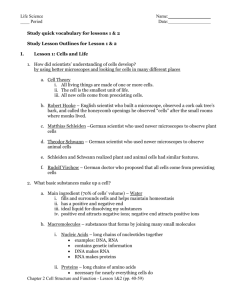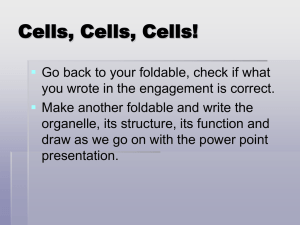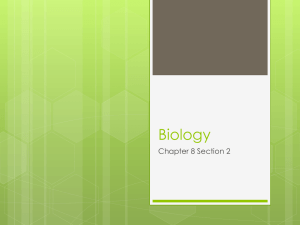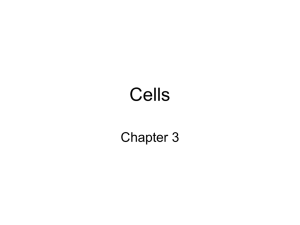Cell Structure & Function Tissues
advertisement
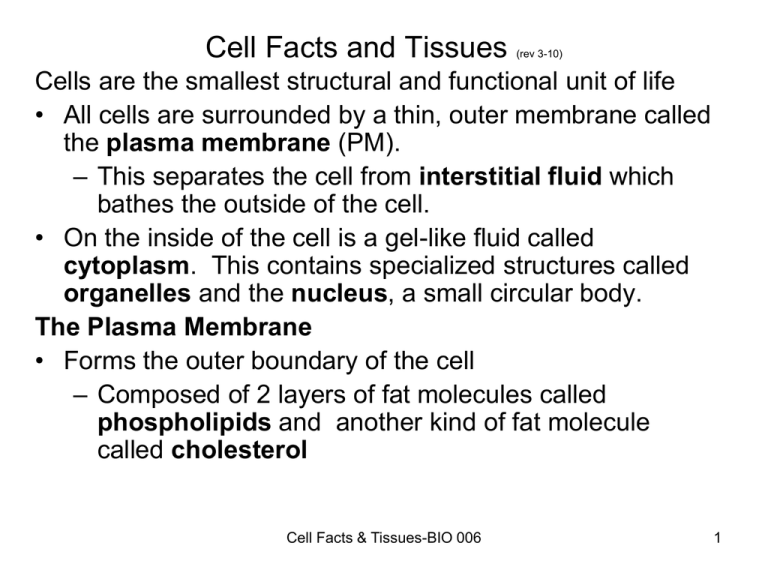
Cell Facts and Tissues (rev 3-10) Cells are the smallest structural and functional unit of life • All cells are surrounded by a thin, outer membrane called the plasma membrane (PM). – This separates the cell from interstitial fluid which bathes the outside of the cell. • On the inside of the cell is a gel-like fluid called cytoplasm. This contains specialized structures called organelles and the nucleus, a small circular body. The Plasma Membrane • Forms the outer boundary of the cell – Composed of 2 layers of fat molecules called phospholipids and another kind of fat molecule called cholesterol Cell Facts & Tissues-BIO 006 1 • The plasma membrane (PM) keeps the cell whole and intact – It serves as a gateway (entrance) between the fluid inside and outside the cell – It identifies a cell as belonging to one particular person; the cell’s surface proteins act as identification tags (each person has different surface proteins) Cytoplasm: composed of a gel-like fluid called cytosol – Lies between the PM and the nucleus – Contains Organelles: structures with specialized functions which are located in the cytoplasm. • Also contains a nucleus. Cell Facts & Tissues-BIO 006 2 Nucleus: • Controls every organelle in the cytoplasm and the cell reproduction process because it contains the genetic code—instructions for making proteins, which in turn determine cell structure and function • directs all functions of the cell. Structural features: • Outer surface is a double-layered nuclear membrane, also called nuclear envelope. • Contains 46 chromosomes which contain DNA, the genetic code Cell Facts & Tissues-BIO 006 3 Figure 3.19a Organelles Ribosomes: tiny particles found throughout the cell; responsible for making enzymes and other protein compounds – Made up of 2 tiny subunits mostly made up of a special kind of RNA— called ribosomal RNA – Ribosomes may be attached to the Endoplasmic Reticulum – Free floating ribosomes produce proteins for use by the cell Cell Facts & Tissues-BIO 006 4 Endoplasmic reticulum (ER) is a system of membranes forming a network of connecting sacs and canals that wind back and forth through a cell’s cytoplasm. – manufactures proteins and chemical compounds produced by the cell. – The sacs and canals carry proteins and other substances through the cytoplasm of the cell from one area to another. Types: rough and smooth • Rough ER: areas where the surface is dotted with ribosomes – Rough ER receives, from the ribosomes, and transports newly made proteins • Smooth ER: Areas without ribosomes – These areas synthesize chemicals and make new cell membrane Cell Facts & Tissues-BIO 006 5 Golgi Apparatus • Group of flattened sacs • Called the chemical processing and packaging center because it collects chemicals from the smooth ER in vesicles Mitochondria: • Provide most of the power for cellular work; nicknamed the cell’s “power plant” • Enzymes found in the mitochondria use oxygen to breakdown glucose to release energy Cell Facts & Tissues-BIO 006 6 Lysosomes • contain digestive enzymes that digest food compounds as well as other substances. – Can destroy microbes Centrioles: used in cell division Cilia: fine, hairlike extensions on the free surface of some cells; are capable of movement Flagella: is a single projection from the cell surface; is larger than cilia; “tails” of sperm cells are the only example of flagella in humans Cell Facts & Tissues-BIO 006 7 Movement of Substances through Cell Membranes • Occurs through passive or active transport • Energy is required only for active transport and is obtained from adenosine triphosphate or ATP – ATP is produced in the mitochondria • Passive transport processes do not require added energy and result in movement “down a concentration gradient” Cell Facts & Tissues-BIO 006 8 • Solution terms – Solute is a substance that dissolves into another substance – Solvent is a substance in which other substances are dissolved Cell Facts & Tissues-BIO 006 9 Passive Transport • Transports a molecule without requiring the cell to use any energy; requires that there be a difference in concentration between 2 areas, called a concentration gradient. • Movement is from area of high to area of low concentration or “down” the concentration gradient • Primary passive transport processes are diffusion and osmosis Cell Facts & Tissues-BIO 006 10 • Diffusion : movement of molecules from one region to another as a result of random movement; – Molecules move from the area of higher concentration to the area of lower concentration • molecules scatter themselves evenly throughout a solution Cell Facts & Tissues-BIO 006 11 Diffusion (Passive transport: no energy required) • Diffusion: movement from area of high concentration to low Cell Facts & Tissues-BIO 006 12 Osmosis is the diffusion of water across a selectively permeable membrane (the solutes cannot cross the membrane) from the region of lower concentration to the area of higher concentration • Selectively permeable means a membrane will permit some substances to pass through it but not others Cell Facts & Tissues-BIO 006 13 Cell Facts & Tissues-BIO 006 14 Active transport • Movement of substances is “up the concentration gradient”— movement from an area of lower to higher concentration • Requires energy from ATP • Ion pumps – An ion pump is a protein structure in the cell membrane • Is called a “carrier” – Ion pumps use energy from ATP to move substances across cell membranes against their concentration gradients – Examples: sodium-potassium pump, calcium pump – Some ion pumps work with other carriers so that glucose or amino acids are transported along with ions Cell Facts & Tissues-BIO 006 15 Na+-K+ Pump 3 sodium ions are pumped out of the cell and 2 potassium ions are pumped in during a pumping cycle of the carrier molecule. ATP is broken down and used for energy to pump the ions Cell Facts & Tissues-BIO 006 16 • Why are passive and active transport important in the human body? – Hint: how do substances move across the plasma membrane? Cell Facts & Tissues-BIO 006 17 Body Tissues • Tissue: group of similar cells that perform a common function • 4 main kinds of tissues – Epithelial – Connective – Muscle – Nervous • Tissues differ from each other in their – Size and shape of cells – Amount and kind of material between the cells – Special functions they perform Cell Facts & Tissues-BIO 006 18 Epithelial Tissue covers the body and lines body cavities – Cells packed closely together • Can be categorized according to shape: – Squamous (flat) – Cuboidal (cube) – Columnar (tall) • Can be categorized according to arrangement-layers of cells: – Simple – Stratified Cell Facts & Tissues-BIO 006 19 EPITHELIAL TISSUE • Absorbs – substances can easily pass through it for example absorption of oxygen into the blood • Secretes – cells function in clusters and form glands which make and release substances to help the body work i.e. saliva, digestive juices, and hormones – cells forms the urine-producing tubules of the kidneys • Protects tissues – when there are several layers of closely packed cells, microorganisms can’t get through them – cilia move mucus and protect against entry of foreign particles into the lung Cell Facts & Tissues-BIO 006 20 Connective tissue • Most abundant tissue in body Most widely distributed tissue in body Multiple types, appearances, and functions - Connects tissues to each other - Forms a supportive framework for the body and the organs - Transports substances throughout the body (blood is a type of connective tissue) - Defends us against microorganisms Relatively few cells in an intercellular matrix Cell Facts & Tissues-BIO 006 21 Types of Connective Tissue • Blood— fluid “tissue”; – function is transportation and protection – cells are suspended in a fluid matrix called plasma. (Considered a connective tissue because all blood cells derive from earlier stem cells located within bone.) Cell Facts & Tissues-BIO 006 22 Areolar: glue that holds organs together Most widely distributed type of connective tissue Cell Facts & Tissues-BIO 006 23 Adipose (fat) • specialized to store lipids •Oil filled cells Cell Facts & Tissues-BIO 006 24 Dense Fibrous •Has bundles of collagen fibers arranged in parallel rows •Provides strength and flexibility; does not stretch •example is tendons and ligaments Cell Facts & Tissues-BIO 006 25 Bone • functions in support and protection •Stores the mineral calcium Cell Facts & Tissues-BIO 006 26 Cartilage •bone will be formed from this type tissue •Matrix is the consistency of firm plastic or a gel Cell Facts & Tissues-BIO 006 27 Muscle tissue: movement “specialist”; can contract Cell Facts & Tissues-BIO 006 28 Skeletal Muscle •also called striated or voluntary; •attaches to bones; •Has striations • is multinucleated • has long cells Cell Facts & Tissues-BIO 006 29 Cardiac Muscle • also called striated or involuntary • forms the walls of the heart •has intercalated disks; fibers branch Cell Facts & Tissues-BIO 006 30 Smooth •also called nonstriated, visceral, or involuntary • found in blood vessel walls and hollow organs • push food and fluids through body Cell Facts & Tissues-BIO 006 31 Nervous tissue provides rapid communication between body structures and control of body functions Consists of 2 types of cells: Neurons—conducting cells Neuroglia—supportive and connecting cells Neurons Cell components o Cell body o Axon (one or more) carries nerve impulses away from cell body o Dendrites carry nerve impulses toward the cell body Cell Facts & Tissues-BIO 006 32
